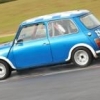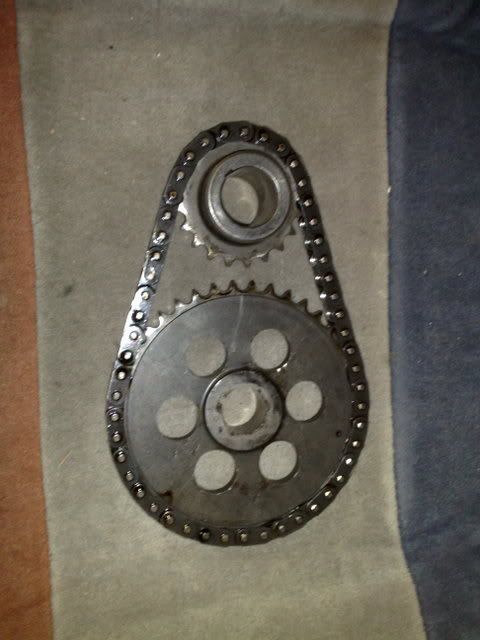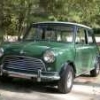
Still Struggling With Camtiming
#1

Posted 27 December 2008 - 07:29 PM
I started a topic around 3 weeks ago and got a few responses, but i still dont udnerstand, today I spoke to a friend whos big into the ford tuning scene.
Hes built engines before and has simply put piston 1 to tdc and then turned the cam until both valves were closed, it seems crude but in theory it should work shoudnt it. Mines a kent 286 cam, would this work???
or would I need a cam dial (which I realy don't understand)
#2

Posted 27 December 2008 - 09:52 PM
On the A-series, start with the pulleys aligned dot-to-dot as per the manuals. That will be close to start with. Then use your DTI on piston #1 to find TDC. The timing protractor is then attached to the front of the crank and a pointer positioned over it. You then move the DTI to the valves to find the max lift point of the appropriate pushrod. When you find that max lift you read the angle on the protractor and begin doing the math. Once you know how many degrees the maximum lift is occurring away from the specified cam angle you either use offset ground key or vernier pulleys to set the timing where you want it.
Again, once you tell us which aspect is confusing we'll be able to elaborate where appropriate.
#3

Posted 27 December 2008 - 10:13 PM
Firstly whats DTI?
And how would I measure when the pushrod is at its hightest point.
I also don't understand how you can precisly change the timing surely its dependant on the timing chain and can only move one tooth at a time so how can it be so accuratly set?
Edited by mini_mad69, 27 December 2008 - 10:16 PM.
#4

Posted 27 December 2008 - 10:56 PM
Ok thanks for the reply. I don't understand any of it realy.
Firstly whats DTI?
And how would I measure when the pushrod is at its hightest point.
I also don't understand how you can precisly change the timing surely its dependant on the timing chain and can only move one tooth at a time so how can it be so accuratly set?
DTI stands for Dial Test Indicator, basically a gauge that you use to detect minute movement in parts(when set up on a stand).
To measure full lift on the inlet you need a DTI on the end of the push rod.
You can precisely time it if you are using vernier timing gears, if your using a 286 i would think you are??
I will take some photos tomorrow if you want, as i am in the middle of building up my engine. There was a thread that described how to do it i'll have a look in a mo.
#5

Posted 27 December 2008 - 11:03 PM
Ok thanks for the reply. I don't understand any of it realy.
Firstly whats DTI?
And how would I measure when the pushrod is at its hightest point.
I also don't understand how you can precisly change the timing surely its dependant on the timing chain and can only move one tooth at a time so how can it be so accuratly set?
DTI stands for Dial Test Indicator, basically a gauge that you use to detect minute movement in parts(when set up on a stand).
To measure full lift on the inlet you need a DTI on the end of the push rod.
You can precisely time it if you are using vernier timing gears, if your using a 286 i would think you are??
I will take some photos tomorrow if you want, as i am in the middle of building up my engine. There was a thread that described how to do it i'll have a look in a mo.
Brilliant, thanks alot that would be brilliant. I posted a thread but the answers I recieved were very technical and advanced. This is my first engine build and im on a tight deadline so Its not ideal. Actualy Il go over to the garage and takesome pictures of my timing gear to see if you can Identify what I have.

Edited by mini_mad69, 27 December 2008 - 11:14 PM.
#6

Posted 27 December 2008 - 11:14 PM
Before leaving this thread though let me offer the comment that an alternative to the vernier pulleys that Mini.Rich mentioned, you can also shift the cam timing a few degrees one way or another using what is called an "offset ground key". These are available from places like Mini Spares. If you're not working on your engine all the time the offset key is a more economical way to get the timing where you want it. And in closing, timing chains stretch. It's not unusual to intentionally set the cam timing a couple of degrees advanced (ahead) of what the cam manufacturer recommends. As the timing chain stretches the cam will come into the correct position.
#7

Posted 27 December 2008 - 11:36 PM
Brilliant, thanks alot that would be brilliant. I posted a thread but the answers I recieved were very technical and advanced. This is my first engine build and im on a tight deadline so Its not ideal. Actualy Il go over to the garage and takesome pictures of my timing gear to see if you can Identify what I have.
to be honest, i would use a fixed duplex chain and offset keys as a minimum, as the simplex chains(pictured) will stretch more than duplex ones. If you want to get the most out of the cam the timing needs to *male chicken*-on, this is best done with either offset keys or verier gear sets. It can be a couple of degrees out but much more and it will start to loose power.
When I wrote my earlier reply I was running out of time. I had been searching YouTube for videos that would walk you through the process using the DTI and degree wheel. I'll check later tonight and see if I can't find some links that will help. Along with info and pictures from Mini.Rich I'm sure it will become more clear.
Before leaving this thread though let me offer the comment that an alternative to the vernier pulleys that Mini.Rich mentioned, you can also shift the cam timing a few degrees one way or another using what is called an "offset ground key". These are available from places like Mini Spares. If you're not working on your engine all the time the offset key is a more economical way to get the timing where you want it. And in closing, timing chains stretch. It's not unusual to intentionally set the cam timing a couple of degrees advanced (ahead) of what the cam manufacturer recommends. As the timing chain stretches the cam will come into the correct position.
Yeah, 'offset ground keys' (the woodruff key/locating key in the end of the cam) are a cheaper alternative to vernier timing setups.
#8

Posted 27 December 2008 - 11:38 PM
Edited by mini_mad69, 27 December 2008 - 11:41 PM.
#9

Posted 28 December 2008 - 12:57 AM
You asked about setting the cam timing by lining up the keys. You do NOT line up the keys. You line up the "dots" on the timing gear hubs. These dots will be visible when the sprockets are installed on the cam and crankshaft. Refer to your Haynes manual for an illustration showing what I'm talking about. As for how to set the timing once the gears are installed... you don't exactly do it that way. You fit the parts temporarily and measure the cam angle to determine what timing by dot-to-dot alignment gives you. Then you refer to the literature supplied by your cam maker. Once you determine what correction you need to get the cam correctly timed you either: 1) adjust the vernier pulley positions to achieve the correct cam timing, or 2) you remove the pulleys and chain, then fit the appropriate offset key to provide the desired angular correction.
If I find a couple of YouTube links that I think will help, I'll post them later. In the meantime, keep reading Vizard and do a little Googling on the topic. You can download a timing disk/wheel template from my storage space. Print this out as large as possible and glue it to a thick piece of cardboard or similar and you'll have a degree wheel.
http://home.mindspri...egreeWheel2.pdf
#10

Posted 28 December 2008 - 01:10 AM
Ben
#11

Posted 28 December 2008 - 01:50 AM
In this video, the narrator has already attached the degree wheel to the crank and placed a pointer on/against it for TDC. Watch what he's doing with the DTI and turning the crank. First you will need to find TDC and place the protractor on the crank such that TDC corresponds to zero degrees on the protractor. Start like the narrator does, but put the DTI on piston #1. Temporarily fit the protractor to the crank and turn the engine over in the direction of rotation stopping equal distances (as measured by the DTI) before and after piston #1 TDC. Record the degrees for those points, average the results, then turn the crank until that average degree value on the protractor aligns with your pointer. Then... loosen the protractor and carefully position it so zero degrees on the protractor lines up with the pointer and secure the protractor firmly to the crank. You have now found TDC and moved the protractor so zero on its scale is indicated by the pointer at that position.
Now... go back to the video and note the DTI has been moved over a pushrod. Do what the narrator does to determine where the max lift occurs. Go to your cam data sheet and do the math to see how many degrees "off" you are from ideal. Then either dial the vernier pulleys in to give you the desired angle... or remove the pulleys and fit your offset cam key.
Keep in mind that the chain will stretch enough to move the timing "backwards" or retarded by about 2 degrees. Therefore, ere on the side of the cam being a bit too advanced rather than retarded.
The vernier kits are nice but they will cost you a bit of money. If you're doing this on a budget, the offset keys are the way to go.
#12

Posted 28 December 2008 - 02:07 AM
I looked over several videos on YouTube and none showed exactly what I was hoping to find. However, do check out this video. I'm adding some additional comments about it below.
In this video, the narrator has already attached the degree wheel to the crank and placed a pointer on/against it for TDC. Watch what he's doing with the DTI and turning the crank. First you will need to find TDC and place the protractor on the crank such that TDC corresponds to zero degrees on the protractor. Start like the narrator does, but put the DTI on piston #1. Temporarily fit the protractor to the crank and turn the engine over in the direction of rotation stopping equal distances (as measured by the DTI) before and after piston #1 TDC. Record the degrees for those points, average the results, then turn the crank until that average degree value on the protractor aligns with your pointer. Then... loosen the protractor and carefully position it so zero degrees on the protractor lines up with the pointer and secure the protractor firmly to the crank. You have now found TDC and moved the protractor so zero on its scale is indicated by the pointer at that position.
Now... go back to the video and note the DTI has been moved over a pushrod. Do what the narrator does to determine where the max lift occurs. Go to your cam data sheet and do the math to see how many degrees "off" you are from ideal. Then either dial the vernier pulleys in to give you the desired angle... or remove the pulleys and fit your offset cam key.
Keep in mind that the chain will stretch enough to move the timing "backwards" or retarded by about 2 degrees. Therefore, ere on the side of the cam being a bit too advanced rather than retarded.
The vernier kits are nice but they will cost you a bit of money. If you're doing this on a budget, the offset keys are the way to go.
Thanks so much, youve been a fantastic help. All of this infomation has now been saved to my computer for future reference. Maybe this could be written up into a "how to article" as its brilliant in understanding cam timing.
Edited by mini_mad69, 28 December 2008 - 02:08 AM.
#13

Posted 28 December 2008 - 02:40 AM
#14

Posted 28 December 2008 - 10:03 AM
Keith Calver has done a good article on this on the Minispares site. It involves a plate, bolted into the stud holes in the block, with a bolt through the centre (centred over the piston). I'll go have a look if I can find the link.
All you're basically doing is using the head of the bolt to see when the piston rises and hits the bolt, then won't go any further. Put a mark on the crank timing dial. Turn engine the other way until it stops on the bolt, put a mark on the timing dial. Then, count the degrees between the two new marks, right in the middle of those two marks is TDC.
Back in a sec.......
#15

Posted 28 December 2008 - 10:12 AM
There is this link:
http://www.minispare...px?ty=ad&aid=68
But to be honest it doesn't cover anything that's not already been covered on here.
1 user(s) are reading this topic
0 members, 1 guests, 0 anonymous users
















